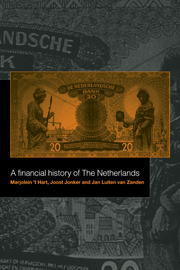Book contents
- Frontmatter
- Contents
- List of figures
- List of tables
- The Republic of the Seven United Provinces
- The Kingdom of the Netherlands
- 1 Introduction
- 2 The merits of a financial revolution: public finance, 1550–1700
- 3 Linking the fortunes: currency and banking, 1550–1800
- 4 From fragmentation to unification: public finance, 1700–1914
- 5 The alternative road to modernity: banking and currency, 1814–1914
- 6 Old rules, new conditions, 1914–1940
- 7 Towards a new maturity, 1940–1990
- 8 Conclusion
- Glossary
- Bibliography
- Index
7 - Towards a new maturity, 1940–1990
Published online by Cambridge University Press: 03 February 2010
- Frontmatter
- Contents
- List of figures
- List of tables
- The Republic of the Seven United Provinces
- The Kingdom of the Netherlands
- 1 Introduction
- 2 The merits of a financial revolution: public finance, 1550–1700
- 3 Linking the fortunes: currency and banking, 1550–1800
- 4 From fragmentation to unification: public finance, 1700–1914
- 5 The alternative road to modernity: banking and currency, 1814–1914
- 6 Old rules, new conditions, 1914–1940
- 7 Towards a new maturity, 1940–1990
- 8 Conclusion
- Glossary
- Bibliography
- Index
Summary
Introduction
The Second World War led to a complete reversal in the perception of the role of the state in the national economy of The Netherlands. The passive role of laissez-faire which it had adopted in the 1930s had been markedly unsuccessful. After the war, therefore, an active policy was implemented which led to the creation of a welfare state. Before we examine the social and economic policies that resulted in the welfare state, we will look closely at the 1940s, where the story is one of war and reconstruction. Special attention must be paid to the financial consequences of the German occupation, notably to the ballooning public debt and money supply, as well as to the ways in which these major financial problems were handled after liberation.
In the financial sector, the post-war period began with the demarcation lines between the different financial institutions still pretty well intact: the various kinds of financial institutions all had their market segments well defined. The late 1950s saw the beginning of a process of diversification and expansion. We will describe this process, sketch the development of the payments system and end by describing how the Nederlandsche Bank reacted to the changing environment.
War and peace
The German occupation
The pressure on the Dutch economy mounted throughout the war years. As in other countries, one of the conditions imposed as part of the surrender to Nazi Germany was the recognition of German occupation currency, the so called Reichskreditkassenscheine.
- Type
- Chapter
- Information
- A Financial History of the Netherlands , pp. 152 - 194Publisher: Cambridge University PressPrint publication year: 1997
- 1
- Cited by

